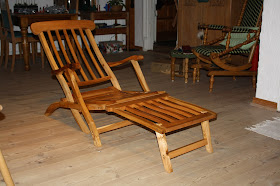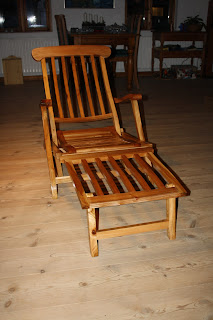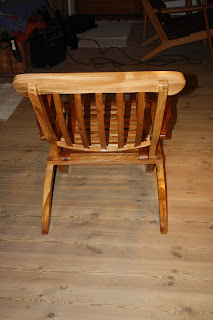Given that the weather on the Norwegian west coast has been bad ever since I signed on the ship, there really hasn't been any possibilities of starting a project.
I did however bring with me a copy of Campaign furniture by Chris Schwartz.
The book is written in a clear and informative language, and there are loads of historical informations to be found.
The projects found in the book strikes me as very well chosen. Based on that they can be used in a normal household today.
I am pretty sure that CS also knows how to make a campaign bed, but that would probably be more of a curiosity to most people, and not something that a lot of people would actually make.
The projects do not appear to be listed according to their difficulty, but more based on how popular that type of project was originally.
In the beginning of the book a lot of general information on campaign furniture is given, changes in styles through the years. General information on hardware and wood species etc.
I personally like the small quotes from older books, such as a guide to India travelers and small original ads for companies that supplied campaign furniture 150 years ago. These small distractions engage my sense of curiosity and imagination.
There is also a whole lot of general information on joinery techniques, and techniques for installing hardware, with all the small but important information provided. Especially when it come to the descriptions on how to install hardware, the book is very thorough. This is in my opinion a very noble approach, as the hardware installation is often a "make or break" operation on a piece of furniture.
The reader is taken step by step through the installation of half mortise locks and corner guards etc. with clear pictures and instructions.
In my opinion the best example of the thoroughness of those descriptions is that CS explains that typically a corner guard will have a very slight radius on the inside corners. And next he describes how to deal with this.
That is information I haven't seen anywhere else. Actually the book can be recommended just based on the instructions for installing hardware.
Regarding the projects themselves, the instructions are equally clear and informative. Each build is described in a logical sequence, and operations that might be difficult are explained in detail regarding what can be done to ensure a success.
There are no descriptions of the exact hardware needed for each project, which is kind of liberating. I guess this is done to allow the builder to use whatever hardware is obtainable in that persons part of the World.
As usual with books from Lost Art Press, the book itself oozes of quality. Nice binding, thick paper, good looking photos and drawings etc.
I would recommend the book to anyone remotely interested in items of campaign style, and also to those who are looking for some detailed instructions in how to mount hardware.
If you should you purchase the book, or the electronic version or both depends on how you like to read. But the book itself is a handy size and of such a quality that it is a joy to read it. So I would just go with the hardbound book. But then again, I am pretty conservative when it comes to things like that.
Sunday, December 27, 2015
Wednesday, December 16, 2015
Titanic deck chair
For once I have made a project which does not involve pallet wood. And furthermore isn't it a box of any kind.
My wife has wished for a deck chair for a couple of years, but I haven't found the time to build her one until now.
The plans for this chair can be found at Popular Woodworking, they were issued in 2012, 100 years after the sinking of the RMS Titanic.
I made my chair out of elm which originally comes from trees belonging to my neighbor. They were among the first boards that I ever milled, so they have air dried for some 8 or 9 years now.
The construction of the chair went along OK, but with a few screw ups along the way, some were my own fault, and some were due to the cut list and plans.
It is not a quick project, but that should come as no surprise with 43 individual parts, of which 26 of them have to be shaped on the band saw.
As a finish I applied two coats of oil based marine varnish.
Since I will sign on the ship tomorrow, I won't be home for Christmas this year. I have therefore already given the chair to my wife, so now it is OK to blog about it, even though it is a present.
That is also the reason why I didn't blog about the build itself.
My wife has wished for a deck chair for a couple of years, but I haven't found the time to build her one until now.
The plans for this chair can be found at Popular Woodworking, they were issued in 2012, 100 years after the sinking of the RMS Titanic.
I made my chair out of elm which originally comes from trees belonging to my neighbor. They were among the first boards that I ever milled, so they have air dried for some 8 or 9 years now.
The construction of the chair went along OK, but with a few screw ups along the way, some were my own fault, and some were due to the cut list and plans.
It is not a quick project, but that should come as no surprise with 43 individual parts, of which 26 of them have to be shaped on the band saw.
As a finish I applied two coats of oil based marine varnish.
Since I will sign on the ship tomorrow, I won't be home for Christmas this year. I have therefore already given the chair to my wife, so now it is OK to blog about it, even though it is a present.
That is also the reason why I didn't blog about the build itself.
Titanic deck chair made of elm.


